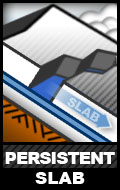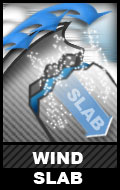Weekend Avalanche Outlook
Dangerous avalanche conditions will exist in the upper elevations of Chugach State Park this weekend. A strong storm affected the area Friday with continuously strong winds and varying amounts of fresh snow. The mountains need time to adjust from all the stress they’ve received the past several days from strong winds, warming temperatures, and precipitation.
Avalanche Problems:
Persistent slab avalanches up to D2.5 in size will be possible for humans to trigger on upper elevation (2500’+) terrain steeper than 35 degrees. Recent snow and continuously strong winds have stressed persistent slabs throughout the park, making them more sensitive and likely to be triggered by a human disturbance. Two primary persistent slab concerns exist: faceting around buried melt-freeze and rain crusts, and depth hoar and basal facets near the ground.
Persistent slabs will be relatively trick to assess, requiring a snowpit with layer analysis and stability tests. They will also be tricky to escape if triggered. They are expected to behave like hard slabs meaning that a human trigger may be able to get into the middle of a slab before it breaks above and around, which makes escape difficult.
Avoid steep, upper elevation terrain (especially if heavily wind loaded). Be mindful of the glaring red flags of danger like recent avalanches, “whumping” (collapsing), and shooting cracks.
Continuously strong winds have built potentially dangerous wind slabs up to D2 in size from Friday’s fresh snow. Steep (35*+) and leeward (primarily west to north aspects) terrain above 2500′ is expected to harbor wind slabs. Watch for shooting cracks. Assess conditions on the fly with pole probing and quick hand pits. Dig a full snowpit and conduct stability tests to better understand the reactivity of potential wind slabs, and how they’re bonding.
Cornices have grown from the recent strong winds and precipitation, and are expected to be especially prone to failing this weekend. Give corniced ridges a wide berth; they can break off much further back than expected (even beyond where they’re overhung). Never approach the edge of a snow-covered ridge, unless you’re sure it’s not corniced. A cornice fall itself is dangerous, but can also trigger a large avalanche as it “bombs” the slope it falls onto.
***
It will be very important to be mindful of the runout zone of any slope you’re on or around, and avoid terrain traps that could greatly exacerbate the consequences of even a small slide. Besides terrain traps that channel debris making for potentially deeper burial, it will be important to be mindful of exposure and consider the possibility of getting swept if something went wrong.
If you recreate in the mountains during the snow season please make sure you have at least a basic level of avalanche awareness that enables you to identify and avoid potentially dangerous avalanche terrain and paths, practice “safe travel protocols for avalanche terrain,” and effectively use avalanche rescue equipment (beacon, shovel, probe).
When you head out for your adventure, leave a “trip plan” with a friend or family member staying in town so they could respond in the event of an accident.
*Click the hyperlinks and icons throughout this page for further learning*



